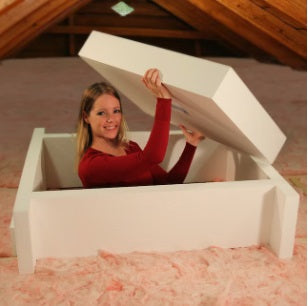How To Prepare Your Attic For Storage
Having an attic provides you with a convenient storage space right above your living quarters. However, utilizing this area to its full potential requires careful strategizing and readiness. This article will guide you through the process of getting your attic ready for storage, from addressing air leaks to selecting appropriate items for storage.
Preparing Your Attic
Attic Space Preparation The initial step in getting your attic storage-ready involves identifying and sealing any air leaks. Such leaks can be found in attic doors, windows, ceilings, walls, among other areas. These gaps can admit dust and pests, which may cause harm to your stored belongings.
Attic Insulation
Additionally, it's critical to ensure that your attic has sufficient insulation, is properly sealed, and well-ventilated. Insulation helps to control the attic's temperature, thus preventing damage to your belongings due to extreme heat or cold. Ventilation prevents moisture accumulation, which could lead to the growth of mold and mildew.
Attic Decking
A robust flooring system is also essential for attic storage. Plywood or similar materials can be used to establish a stable surface for your items. Sealing air leaks in the attic is an essential part of preparing your attic for storage. Air leaks can allow dust, pests, and moisture in, which can harm your stored items.

Here's how to address air leaks in your attic: Identify the Leaks: Start by locating the air leaks. You can do this by closing all the doors and windows, placing a box fan in one window, and covering the remaining openings around the fan.
Seal Small Cracks and Gaps: Apply weatherproof caulk around any gaps or cracks in the attic that are smaller than ¼ inch. Ensure to use heat-resistant caulk around areas that may get hot. Seal Large Openings: For larger gaps, consider using expandable foam spray or mastic sealant. Expanding foam is ideal for filling larger gaps, while mastic sealant is suitable for sealing around ducts and pipes.
Attic Hatch Covers
Seal the Attic Hatch: The attic hatch or door often contributes significantly to air leaks. Seal it by caulking between the hatch frame and the rough opening, or by installing foam weatherstripping around the hatch's perimeter.


Cover Cutouts with Caulk or Foam: Prevent air leaks by sealing the cutouts from above using acrylic latex or silicone caulk, or with low-expansion polyurethane foam, depending on the cutout size.
After sealing the air leaks, cover the area with insulation for added protection against air leaks and to help regulate the attic temperature. Always remember, safety comes first! Wear protective gear, like gloves and a mask when working in the attic.
Selecting Suitable Storage Containers The best type of storage container for an attic is airtight, clear plastic boxes. These boxes shield your items from dust and pests while allowing you to see their content without opening them.
Choosing the right storage container for attic use can seem challenging given the many available options - from totes and bins to boxes and baskets. So, how do you find the best fit for your attic storage needs? And more importantly, how do you transport these containers to your attic? An attic lift is a safe way to do that.
Understanding the unique characteristics of attic storage is key. Before rushing off to Home Depot, Lowes, Target, Wal-Mart, or Amazon, consider the following: Start by reevaluating your attic space, keeping in mind the type of storage bins you'll need. Take along a tape measure and notepad, plan what you want to store and where. This approach aims at maximizing convenience. The types and sizes of containers you choose will largely depend on the different storage areas in your attic.
Consider your attic flooring. If you have an attic flooring system, sturdy bins can be placed between the attic floor joists, but be careful as slipping could cause the bin to break through the ceiling below. If you're planning to span the floor joists, you'll need a long enough storage container. Measure the distance between joists.
If your attic has some flooring, moving bins around will be easier. Bigger bins and footlockers often come with wheels and handles for easy transportation. However, if your attic flooring is minimal, consider the weight of your loaded storage containers and how they will be transported. Smaller containers may prove more convenient than larger ones.
Next, examine your attic ceiling or house roof. Height restrictions will limit your available storage space. Planning ahead can help you make the most of the vertical space. For instance, bins of different heights can be used to maximize storage - lower ones can be tucked in closer to the eaves while taller or stackable containers can be placed towards the center.
Lastly, consider the type of attic truss system you have. Measure the space between trusses and select storage containers that can easily move around them.
Choosing Items for Attic Storage Not all possessions are ideal for attic storage due to the potential for heat damage, particularly during summer months. Photos, wooden items, and other heat-sensitive materials may not fare well in such conditions.
Rather, opt to store items that can withstand heat, such as holiday decorations, suitcases, and other infrequently used items. Refrain from storing items of high value or irreplaceability in the attic as they could be irreparably damaged by unforeseen issues like leaks or pest infestations.
Structuring Your Attic Storage After preparing your attic and selecting appropriate items for storage, the next step is to arrange everything systematically. Utilize hanging space for items like wreaths, clothes, and outdoor lights to maintain easy access and free up shelf space for larger items. Employ clear storage bins for smaller objects and label them for simple identification.
Consideration should also be given to the frequency of access when positioning items; less frequently needed items should go to the back, while those needed more often should be closer to the entrance. To conserve space and protect against pests and dust, consider vacuum sealing seasonal clothing.
Upkeep of Your Attic Storage Even after establishing your attic storage, regular upkeep is crucial. Regularly check for pests and clean the space to prevent dust accumulation. Monitor the temperature and humidity levels to ensure they remain within safe parameters for your stored items. In summary, while the task of preparing your attic for storage may initially seem overwhelming, with thoughtful planning and organization, it's entirely possible to establish a functional storage space that keeps your items secure and readily accessible.


Leave a comment